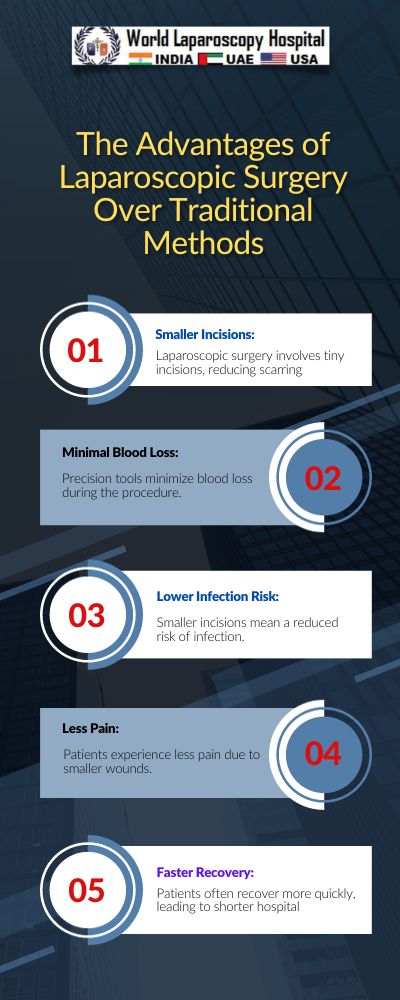The Advantages of Laparoscopic Surgery Over Traditional Methods
Introduction
In the world of modern medicine, surgical procedures have come a long way from their humble beginnings. Traditional open surgeries, characterized by large incisions and prolonged recovery times, have been largely replaced by minimally invasive techniques. One such innovation that has revolutionized the field of surgery is laparoscopic surgery. This article will delve into the advantages of laparoscopic surgery over traditional methods, shedding light on how this cutting-edge approach has transformed patient outcomes and healthcare as a whole.

The Evolution of Surgery
Surgery has been an integral part of medical practice for centuries, dating back to ancient civilizations. Historically, surgical procedures were often limited by the tools and knowledge available at the time. Traditional methods, which involve large incisions and direct exposure of the surgical area, were the norm for centuries. While these methods saved countless lives and paved the way for modern surgery, they also came with significant drawbacks.
The Emergence of Laparoscopic Surgery
Laparoscopic surgery, also known as minimally invasive surgery, emerged as a game-changer in the mid-20th century. This innovative approach involves making tiny incisions, through which specialized instruments and a camera are inserted to perform the surgery. The surgeon views the procedure on a monitor and manipulates the instruments with precision, all while minimizing trauma to the patient's body. This technique marked a paradigm shift in surgical practice and brought forth a multitude of advantages that we will explore in detail.
Advantages
Minimal Scarring
One of the most visible and immediate advantages of laparoscopic surgery is the minimal scarring it leaves behind. Traditional open surgeries often result in large, unsightly scars that can be emotionally distressing for patients. In contrast, laparoscopic procedures require only small incisions, typically less than an inch in length. These tiny scars are far less conspicuous and contribute to improved cosmetic outcomes, which can be particularly important for patients.
Reduced Pain and Discomfort
Traditional surgery involves cutting through layers of tissue and muscle, which can lead to significant postoperative pain and discomfort. Patients may require extended hospital stays and heavy pain management medications. Laparoscopic surgery, on the other hand, is less invasive and typically results in less pain. Smaller incisions mean less damage to surrounding tissues, reducing postoperative pain and the need for strong pain medications.
Faster Recovery
The quicker recovery time associated with laparoscopic surgery is another compelling advantage. Traditional surgical procedures often require extended hospital stays and prolonged periods of rest and recuperation. In contrast, patients undergoing laparoscopic surgery often experience shorter hospital stays and faster recoveries. This allows individuals to return to their daily activities and work sooner, leading to improved overall quality of life.
Lower Risk of Infection
Infections are a common concern following surgery. Large incisions in traditional surgery can provide entry points for bacteria, increasing the risk of postoperative infections. In laparoscopic surgery, the smaller incisions reduce this risk significantly. Additionally, the minimally invasive approach often results in less tissue exposure, further lowering the chance of infection. This is a crucial advantage, as postoperative infections can lead to serious complications and additional healthcare costs.
Less Blood Loss
Blood loss during surgery can be a significant concern, especially for patients with certain medical conditions or those undergoing complex procedures. Laparoscopic surgery typically results in less blood loss compared to traditional methods. The precision of the instruments used in laparoscopic procedures and the smaller incisions contribute to this advantage. Reduced blood loss not only decreases the need for transfusions but also minimizes the stress on the patient's body.
Improved Visualization
Visualization is a critical aspect of any surgical procedure. In traditional surgery, the surgeon relies on direct line-of-sight to the surgical site, often requiring extensive dissection and manipulation of tissues to gain access. Laparoscopic surgery, however, provides superior visualization through the use of a high-definition camera system. This magnified and well-lit view allows for greater precision and accuracy during the procedure, reducing the risk of errors.
Less Trauma to Surrounding Tissues
Traditional open surgeries can result in significant trauma to surrounding tissues and organs as they are moved or manipulated to access the surgical site. In laparoscopic surgery, the small incisions and specialized instruments are designed to minimize this trauma. This leads to less tissue damage, reduced risk of complications, and quicker healing for patients.
Lower Healthcare Costs
While the initial cost of laparoscopic equipment and training may be higher, the long-term cost benefits are significant. Shorter hospital stays, reduced need for pain medications, and quicker recoveries all contribute to lower overall healthcare costs. Patients and healthcare systems alike benefit from these cost savings, making laparoscopic surgery an economically viable option.
Enhanced Surgeon Ergonomics
Laparoscopic surgery not only benefits patients but also improves the working conditions for surgeons. The ergonomic design of laparoscopic instruments allows for more comfortable and precise movements, reducing the physical strain on the surgeon. This can lead to improved surgical outcomes and career longevity for medical professionals.
Expanding the Range of Treatable Conditions
The advantages of laparoscopic surgery have led to its application in a wide range of medical specialties. While it was initially used for simple procedures like gallbladder removal, it has since been adapted for more complex surgeries, including colorectal, gynecological, and even cardiac procedures. This expansion of laparoscopic techniques has broadened the scope of conditions that can be effectively treated with minimally invasive surgery.
Conclusion
Laparoscopic surgery has undeniably revolutionized the field of surgery by offering a plethora of advantages over traditional methods. From minimal scarring and reduced pain to faster recovery times and improved patient outcomes, the benefits are clear and far-reaching. While traditional open surgery will always have its place in medicine, the continued development and adoption of laparoscopic techniques promise to further enhance the quality of care patients receive. As technology advances and surgical skills continue to evolve, the future of surgery appears increasingly minimally invasive, ushering in an era of better, safer, and more efficient healthcare for all.
| Older Post | Home | Newer Post |





